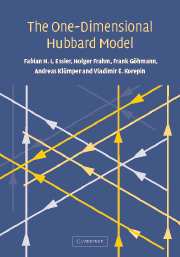Book contents
- Frontmatter
- Contents
- Preface
- 1 Introduction
- 2 The Hubbard Hamiltonian and its symmetries
- 3 The Bethe ansatz solution
- 4 String hypothesis
- 5 Thermodynamics in the Yang-Yang approach
- 6 Ground state properties in the thermodynamic limit
- 7 Excited states at zero temperature
- 8 Finite size corrections at zero temperature
- 9 Asymptotics of correlation functions
- 10 Scaling and continuum limits at half-filling
- 11 Universal correlations at low density
- 12 The algebraic approach to the Hubbard model
- 13 The path integral approach to thermodynamics
- 14 The Yangian symmetry of the Hubbard model
- 15 S-matrix and Yangian symmetry in the infinite interval limit
- 16 Hubbard model in the attractive case
- 17 Mathematical appendices
- References
- Index
1 - Introduction
Published online by Cambridge University Press: 19 August 2009
- Frontmatter
- Contents
- Preface
- 1 Introduction
- 2 The Hubbard Hamiltonian and its symmetries
- 3 The Bethe ansatz solution
- 4 String hypothesis
- 5 Thermodynamics in the Yang-Yang approach
- 6 Ground state properties in the thermodynamic limit
- 7 Excited states at zero temperature
- 8 Finite size corrections at zero temperature
- 9 Asymptotics of correlation functions
- 10 Scaling and continuum limits at half-filling
- 11 Universal correlations at low density
- 12 The algebraic approach to the Hubbard model
- 13 The path integral approach to thermodynamics
- 14 The Yangian symmetry of the Hubbard model
- 15 S-matrix and Yangian symmetry in the infinite interval limit
- 16 Hubbard model in the attractive case
- 17 Mathematical appendices
- References
- Index
Summary
The purpose of this opening chapter is threefold: to introduce the Hubbard model, to discuss its origin and significance and to give a brief summary of its history. Rather than beginning with more general and historical considerations we will start with a concrete albeit somewhat technical discussion of how the Hubbard model arises as an effective description of electronic degrees of freedom in solids.
On the origin of the Hubbard model
The Hubbard model is named after John Hubbard, who in a series of influential articles [201–206] introduced the Hamiltonian in order to model electronic correlations in narrow energy bands and proposed a number of approximate treatments of the associated many-body problem. Our following discussion of how the Hubbard Hamiltonian arises in an approximate description of interacting electrons in a solid loosely parallels Hubbard's original work. We will assume that the reader is familiar with the basic concepts of solid state theory (see e.g. [25, 509]) and with the formalism of second quantization (e.g. [283]). For further reading we refer to the original literature [188, 201, 233] and to the monographs [27, 158, 498].
A solid consists of ions and electrons condensed in a three-dimensional crystalline structure. Since the ions are much heavier than the electrons, it is often a good phenomenological starting point for the exploration of the electronic properties of solids to think of the ions as forming a static lattice.
- Type
- Chapter
- Information
- The One-Dimensional Hubbard Model , pp. 1 - 19Publisher: Cambridge University PressPrint publication year: 2005

